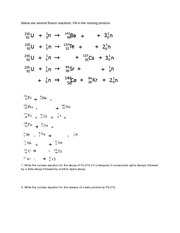
- #NUCLEAR FUSION AND FISSION WORKSHEET ANSWERS HOW TO#
- #NUCLEAR FUSION AND FISSION WORKSHEET ANSWERS FREE#
As the nucleus elongates, nucleons are no longer so tightly packed, and the repulsive electromagnetic force can overcome the short-range strong nuclear force.

This is why the model is known as the liquid drop model.
#NUCLEAR FUSION AND FISSION WORKSHEET ANSWERS FREE#
The catalyst typically occurs in the form of a free neutron, projected directly at the nucleus of a high-mass atom.Īs shown in Figure 22.30, a neutron strike can cause the nucleus to elongate, much like a drop of liquid water. As a result, a physical catalyst is necessary to produce useful energy through nuclear fission. And although it is true that huge amounts of energy can be released, considerable effort is needed to do so in practice.Īn unstable atom will naturally decay, but it may take millions of years to do so. Given that it requires great energy separate two nucleons, it may come as a surprise to learn that splitting a nucleus can release vast potential energy. The short answer questions are conceptual and meant to see if the students are able to apply what they've learned in the unit.In simplest terms, nuclear fission is the splitting of an atomic bond. The vocabulary words can be found scattered throughout the different instructional worksheets from this unit. The study guide is divided into two sections: vocabulary and short answer questions. Purpose: Once the instruction for the unit is completed, students can complete this study guide to aid in their preparation for a written test. Nuclear Energy Study Guide View Worksheet In this lab, students will use colored water to simulate the decay of Strontium-90, while doing some calculations to see how long it takes the radioactive isotope to become harmless.Įssential concepts: Nuclear waste, radioactive half-life. Spent fuel has been accumulating in dry cask storage at the world's nuclear facilities for decades, and no long-term disposal plan has established by the scientific community.
#NUCLEAR FUSION AND FISSION WORKSHEET ANSWERS HOW TO#
Purpose: One of the biggest challenges facing nuclear energy is the problem of how to deal with the waste. Nuclear Waste Half-Life Lab View Worksheet

Students will use the periodic table to predict the alpha and beta decay products of different radioactive elements.Įssential Concepts: Radioactive decay, alpha particles, beta particles. Purpose: This is a worksheet of radioactive decay practice problems. Cockroaches, flour beetles, and fruit flies are all exposed to varying levels of radiation and their survival tracked over a period of 30 days.Įssential Concepts: Radioactive decay, radioactive fallout, acute, chronic, alpha particles, beta particles, gamma rays.Īlpha and Beta Decay Worksheet View Worksheet Purpose: This episode of Mythbusters tries to answer the question of whether cockroaches could really survive a nuclear disaster or war. Mythbusters - Radiation and Cockroaches Worksheet View Worksheet This episode covers the conditions that led to the birth of the sun, the nuclear fusion within that fuels it, sunspots, solar flares, and the predicted eventual death of the sun.Įssential Concepts: Nuclear fusion, radiation, convection, sunspots, solar flares. Purpose: This is a worksheet to accompany the Secrets of the Sun episode of the Universe documentary series.

The Universe - Secrets of the Sun View Worksheet These are helpful to use if you have students who struggle with effective note-taking and either write nothing down at all or try to write everything (and fail to listen to actual lecture). Purpose: This is a fillable notes outline to accompany the nuclear energy Powerpoint. Nuclear Chemistry Student Notes Outline View Worksheet Students will then learn about both nuclear fusion and fission within the context of the sun, fission nuclear reactors, and nuclear weapons.Įssential Concepts: Nucleus, protons, neutrons, radioactive decay, radioactive fallout, fission, fusion, nuclear energy, nuclear meltdowns, half-life. Purpose: This Powerpoint lecture gives a brief history of the discovery and application of radioactivity, including Becquerel's discovery and Rutherford's gold foil experiment. Nuclear Chemistry Powerpoint Lecture View Powerpoint Nuclear fission, fusion, and decay all primarily involve changes to the composition of the nucleus of the atom, so students will be able to apply what they know about protons, neutrons, and atomic mass. Having been introduced to the basic structure of atoms and the use of the periodic table, this is an opportune time to introduce basic nuclear chemistry.


 0 kommentar(er)
0 kommentar(er)
